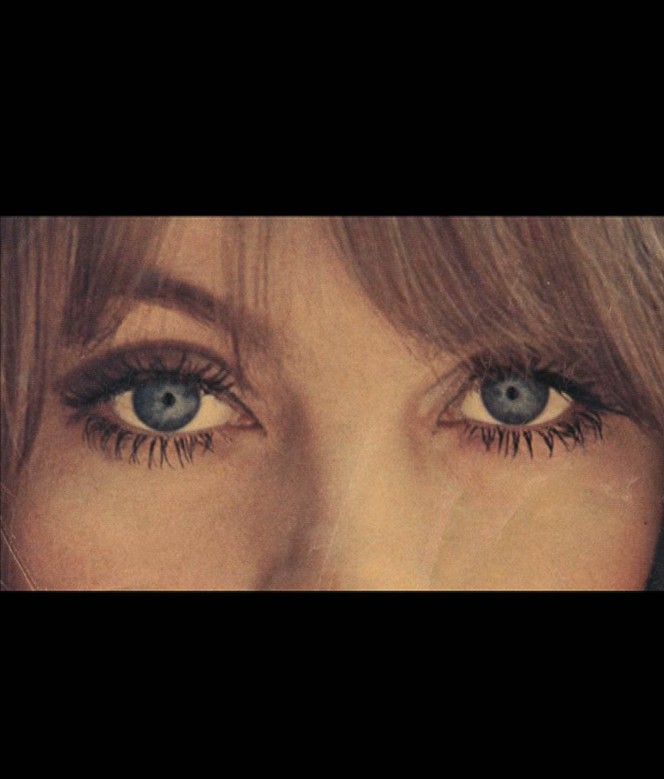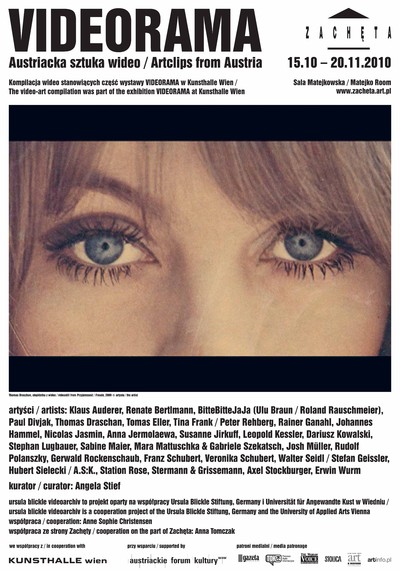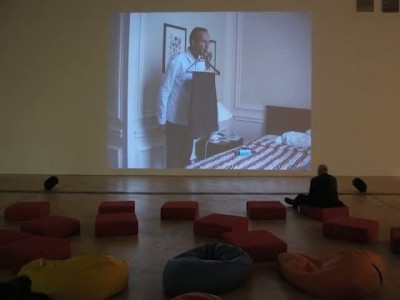The everyday activities of twenty-first-century human beings take place in what theorists call “reality”, 1 spaces shaped by media – be it traditional media such as telephone, radio, television, and cinema, or the Internet, Facebook, and blogs, which have long since crept into our lives and established links with our inner worlds. Visitors to Videorama, too, are rocked by a steady flow of moving images. In the show, today’s mingling of reality and virtuality is reflected in a staging of “reality”, a merging in the viewer’s perception of exhibition space and time-based artwork. The juxtaposition of video works creates experiential spaces and eloquent image combinations: in a dialectics of visual overload and aesthetic concentration, the viewer immerses him/herself in a setting at the same time as heightening the sensitivity and fine-tuning of his/her perceptive apparatus.
The works presented in Videorama operate with different time modes; there are narrative works, clip-like videos and works based on duration that explore atmospheres, spaces, and moods via stretching in time. In the center of the show is a half hour video program, with a compilation of eleven videos that are not only selected by content but also by an image-sound-relation. The videos are arranged on four projections after and along side of each other.
The parameters of the media video – time, image and sound – are translated to an exhibition choreography. A further focus in the show consists of animations often with a self-made attitude intended as a counterweight to elaborate films as well as works with a technoid and aggressive aesthetic.
NARRATING
I don’t limit myself to what might be historically reasonable or feasible but expand the scope of cinematic production to the point of anachronistic paradigms that obey only the structure of the film itself.
Rainer Ganahl
The enjoyment of storytelling is unbroken. The point of departure for the short stories here are biographies, theater plays, television series, and plots written by the artists themselves which become distinctive, ethical, immoral, absurd, intelligent, and funny pieces. Rainer Ganahl, Mara Mattuschka & Gabriele Szekatsch and Paul Divjak supply the show’s most narrative works.
Rainer Ganahl’s film Ce qui roule is set at the end of the nineteenth century, featuring the artist himself in the role of Alfred Jarry, the inventor of pataphysics, and his hero Père Ubu.
Nonsense logic and Jarry’s fantasies of futuristic machines and pills that overcome physical limitations are pitted against the near identical female scientists and the anal circuitry in Mara Mattuschka & Gabriele Szekatsch’s Unternehmen Arschmaschine. Like the other two works, this expressive black-and-white film with its futuristic retro-aesthetic and exploration of symmetries is situated in a temporal nowhere, a history-free zone of playful visual pleasure.
In his video Sonnenland (Sun Land), for which he filmed handicapped children, Paul Divjak outlines a sensitive approach to seeing and being seen, addressing the fine line between documentation and voyeurism via a socio-politically controversial subject. Rather than violating privacy, his camera captures the direct, playful, and authentic interaction between those involved in the video shoot.
- Mara Mattuschka & Gabriele Szekatsch, Enterprise of the ass / Unternehmen Arschmaschine, 1997, 16 min 18 s, courtesy the artists, © the artists
- Rainer Ganahl, Ce qui roule, 2008, 36 min 30 sec, courtesy the artist, Les Laboratoire Paris, Fruit and Flower Deli New York, Elaine Levy Project Bruxelles, © the artist
- Walter Seidl, Untitled (Galotti), 2009, 6 min 59 sec, courtesy the artist, © photos: Walter Seidl, Text & voice-over: Elfriede Jelinek, music: Stefan Geissler, Production: Stefan Geissler & Walter Seidl
- Paul Divjak, Sun Land / Sonnenland, 2000, 15 min 45 sec, Courtesy the artist, distribution & sales: sixpackfilm, © the artist
TRANSFORMING
„Could there possibly be common foot ants that only come out of their hiding places when the foot is asleep?” BitteBitteJaJa, Cadavre Exquise Vivante. Erasmus von Rotterdam
Renate Bertlmann paints with the camera. Her Short Cuts – serial visual impressions accompanied by discreet sounds – show kaleidoscopic refractions of colors and shapes, fabrics embroidered with stones, expressive fashion, the melancholy of a slow pan across deserted spaces, pathos-laden urban imagery accompanied by the music of Arvo Pärt. With her explicitly photographic eye and her use of blurring, Bertlmann penetrates reality. Her sensual works and dissolves stage transitions, describing changes and mutations, something also suggested by her work Formationen with latex objects.
In Axel Stockburger’s Bestiarium, a Viennese dandy from the 8th district spends forty minutes reciting words whose meaning – they are actually Pokemon names – is only accessible to those in the know.
This strange almost mystically invocation is confronted by the Cadavres Exquises Vivantes by BitteBitteJaJa. They refer to André Bretons surrealist quote „Le-cadavre-exquis-boira-le-vin-nouveau”. Alternately and without knowing which film clip the other of both artists selects, Roland Rauschmeier and Ulu Braun add horizontal film fragments as a person, action and scenery to a moving picture. The found footage material comes from films like Satansbraten from Rainer Werner Fassbinder and TV documentations. A surrealité crossing the cinematic reality orginates – a frankenstein monster floating above the ground.
Working on a metaphorical level, Anna Jermolaewa’s cynically entitled socio-critical video The way up shows caged rats on a market in Mexico City. They try in vain to climb up the slippery glass wall to free themselves – a hopeless struggle for survival! The viewer is irritated by a strange mix of pity and disgust, a feeling that burns itself into memory with hyperrealist urgency like a horror film.
- BitteBitteJaJa (Ulu Braun / Roland Rauschmeier), Exquisite Living Corpse / Cadavre Exquis Vivant – Erasmus von Rotterdam, 2009, 1 min 30 sec, courtesy the artist, © the artists
- BitteBitteJaJa (Ulu Braun / Roland Rauschmeier), Exquisite Living Corpse / Cadavre Exquis Vivant – Henri Bequerel, 2009, 1 min 20 sec, courtesy the artist, © the artists
- BitteBitteJaJa (Ulu Braun / Roland Rauschmeier), Exquisite Living Corpse / Cadavre Exquis Vivant – Kaspar Hauser, 2009, 1 min 20 sec, courtesy the artist, © the artists
- Paul Divjak, Journey, 1 min 20 s, courtesy the artist, distribution & sales: sixpackfilm, © video: Paul Divjak, Sound: Hans Platzgumer Station Rose, Nature film / Naturband, 1985, 3 min 35 sec, courtesy the artists, © the artists
- Renate Bertlmann, Shortcuts – Alien, 2002, 2 min 37 sec
- Renate Bertlmann, Shortcuts – Lookingglass, 2001, 1 min 38 sec
- Renate Bertlmann, Shortcuts – Zwitscherlitanei, 2002, 2 min 10 sec
- Renate Bertlmann, Shortcuts – Rocking chair, 2001, 1 min 50 sec
- Renate Bertlmann, Shortcuts – Formationen, 2001, 2 min 51 sec
- Renate Bertlmann, Shortcuts – D 29-X, 1 min 53 sec
courtesy the artist, © video: the artist, music: Jochen Vetter / Helmut Scherner
- Josh Müller, tone and music / le ton et la musique, 2006/2008, 5 min 44 sec, courtesy the artist, © the artist
ABSTRACTING
One of my great endeavors, shared by my colleagues, is to define art as the total event in which sound, object, movement, color, psychology are connected – so that (human) life may be art.
Wolf Vostell
The art of Axel Stockburger and Thomas Draschan overtaxes delicate perceptory apparatuses: the images in Abstraction and Freude (Joy) beat down on the viewer’s senses in a rapid staccato. Thomas Draschan takes as his raw material magazines found on flea markets, while in his video series Aleph, Axel Stockburger defines keywords like “abstraction” and shows the result of a neutral online search of archives and image databases. In this way, the nominal term ‘abstraction’ undergoes a word-image translation performed not by the artist himself but by millions of web users. The pictures succeed each other at such great speed that they are pushed to the limits of identifiability – using speed, Stockburger and Draschan dissolve figurative subjects into abstraction and show different ways of approaching the current flood of images and information: efforts to impose systematic order contrast with the subjective passion of the collector. What remains is a flicker of visual fragments which, like scraps of dreams or splinters of consciousness, stimulate the brain and keep it jumping and alive.
In Starlight by Tina Frank and Peter Rehberg, video flicker is presented as a synesthetic experience of computer-generated, abstract image and synthetic sound. The modulations of color, sound, form, and speed become electronic labyrinths in which consciousness can lose its way.
- Axel Stockburger, Abstraction, 2008, 1 min 8 sec, courtesy: Kunstverein Medienturm, Edition Medienturm © the artist
- Nicolas Jasmin, What we / Was Wir, 1998–2009, 1 min, courtesy the artist © the artist
- Nicolas Jasmin, All visible objects, 1988–2009, 1 min, courtesy the artist © the artist
- Thomas Draschan, Joy / Freude, 2009, 2 min 16 sec, courtesy the artist © the artist
- Tina Frank / Peter Rehberg, Starlight 1, 2003, 3 min 16 sec, courtesy the artist © Video: Tina Frank, Audio: Peter Rehberg
ANIMATING
Animation is not the art of making pictures that move but the art of movements that are drawn.
Norman McLaren
The composition of autonomous individual works by one or more artists into installation-based meta-scenarios creates dense atmospheres of emotional urgency, interferences, irritating dissonances and correspondences. In the exhibition display, real space, which is blacked out in the cinema and in the black box, is an ever-present performance space. In the group show, Videorama brings together many voices that unfold alongside one another as a chorus.
In People who like Bonnie Tyler, Susanne Jirkuff redraws fans from Bonnie Tyler’s homepage and gives them real voices, all of which join to sing her hit Total Eclipse Of The Heart. The animation deals with pop and fan culture, deconstructs the myth of the star, and creates a platform for a directed reenactment via public participation.
Other animations are presented, for example, by Gerwald Rockenschaub, Veronika Schubert, and Hubert Sielecki. Sielecki’s Buchfabrik (Book Factory) recalls the physical chain reaction of everyday objects in the video classic Der Lauf der Dinge (The Way Things Go) by Fischli/Weiss.
Veronika Schubert breaks with linear narrative structures in her animated collage Tintenkiller (Ink Killer), in which she combines excerpts from the German television series Tatort (Crime Scene) on the levels of dialog and image into film montages in blue ink.
The moving images presented in this show, go with the flow of this days some perfectionist others trashy and also show a lot of sacasm as the works Adelphi Sculptures by Erwin Wurm or Affentheater from Anna Jermolaew.
Rudolf Polanszky’s Der musikalische Affe II. Gedächtnis und Musik. Wiener Fassung (The Musical Ape II. Memory and Music. Viennese version) recalls the aesthetic of early video art. In the nine-screen split format, Polanszky creates a cacophony that presents the artist in an orchestral play of dissonances with himself: the self as a schizophrenic fragmenting of personality that experiments with parallel identities and makes the video loop spin off into infinity via the leitmotiv of the spiral.
- Rudolf Polanszky, Der musikalische Affe II, Gedächtnis und Musik, Wiener Fassung, 2006, 5 min 4 sec, courtesy Galerie Konzett, © the artist
- Erwin Wurm, Adelphi Sculptures, 1999, 18 min 15 sec, courtesy the artist © the artist
- Anna Jermolaewa, Monkey Theatre / Affentheater, 2002, 3 min 8 sec, courtesy the artist © the artist
- Susanne Jirkuff, People who like Bonnie Tyler, 2009, 60min 4 sec, courtesy the artist © Video: the artist, Composition: Jim Steinman
- Susanne Jirkuff, Hold us down, 2005, 5 min 24 sec, video: Susanne Jirkuff, music: Rae and Christian, feat. the Congos © the artist
- Gerwald Rockenschaub, ohne Titel / untiteled, 2001, 3 min 31 sec, courtesy Galerie Mehdi Chouakri, Berlin, © the artist
- Hubert Sielecki, Books factory / Buchfabrik, 2008, 3 min, courtesy the artist © the artist
- Hubert Sielecki, (Filmgruppe A.S.K.: mit Paul Braunsteiner, Josef Nermuth), Hero / Die Helden, 1992, 5 min 10 sec, courtesy the artist © the artist
- Veronika Schubert, Tintenkiller / Inkkiller, 2009, 4 min 30 sec, courtesy the artist © the artist
- Franz Schubert, Candle / Kerze, 3 min 11 sec, courtesy the artist
ACTING
“To intervene: to come between as an influencing force; to come in to modify, settle, or hinder some action, argument, etc.”
In performances, interventions, and documentaries, Leopold Kessler, Stephan Lugbauer, and Stermann & Grissemann show different forms of subtle resistance to societal norms, clichéd behavior, and social conditions. Their critical videos in the tradition of artistic activism approach subjects from unusual angles, generate scope for action, and present strategies for survival.
In their cabaret routines, Stermann & Grissemann address misgivings within society and dig deep into the darker parts of the Austrian soul. Their cynical numbers deal with xenophobia, racism, and Germanness. With anarchic humor, they distort social and political conditions in a revelatory way.
Leopold Kessler is interested in the organization of public space and the rules that govern it.
In Privatisiert/Paris (Privitazed/Paris), he takes ordering systems to absurd lengths: during the day he installs devices on streetlamps and uses remote control to switch the lights off at night. As so often in his work, he interrupts and questions infrastructures which appear to serve the citizen and which convey the impression of a “safe” self in a controlled and functioning public sphere. Where is the line between private and public? Who does the city belong to?
In Evoluciones, his documentary filmed in Mexico City, Stephan Lugbauer shows how the street is used to earn a living: in images and interviews, he follows the performances of a father and his two sons who dress as clowns and entertain people sitting waiting in cars stuck in traffic.
- Leopold Kessler, Privatisiert/Paris, 2005, 3 min, courtesy Galerie Andreas Huber, Wien, © the artist
- Stermann & Grissemann, German Telephone – Quiz / Das deutsche Telefon-Quiz, 2007, 2 min 14 s
- Stermann & Grissemann, Dancing Stars, 2005, 2 min 3 sec
- Stermann & Grissemann, German Cooking Hour / Die deutsche Kochstunde, 2006, 2 min 49 sec
- Stermann & Grissemann, Poetry Slam, 2007, 2 min 24 sec
Regie: David Schalko, Eine Produktion des © ORF Alle Rechte vorbehalten
- Stephan Lugbauer, Evolutions / Evoluciones, 2007, 8 min 18 sec, courtesy the artist © the artist
- Anna Jermolaewa, The way up, 2008, 3 min 14 sec, courtesy the artist © the artist
- Klaus Auderer, Tomorrow we are dead (Excerpt from the video cycle), 2004–2008, 10 min, courtesy Galerie Christine Mayer, München; Galerie Sabine Knust, München; Galerie Dana Charkasi, Wien
© the artist
MOVING
Interstate, a work by Dariusz Kowalski presents an American highway as a public space and place of social interaction. The image was not registered with a video camera but out of photoshots. The soundtrack wasn’t recorded on place but downloaded from the Internet. In Kowalski’s movie actions taking place in the real space, like acceleration and deceleration, immobility and speed, were brought to absurd. This artist, living in Vienna, reflects functions and coordinates of video medium and its temporal changeability in his works. Works by Johannes Hammel, Nicolas Jasmin, Sabina Maier and Marcus Shinwald also focus on place and medium, concentrate on a body in motion and what determinates it. A performer possessed by sound in Johanes Hammel's work System of Transitions, moves between surface and abyss, thanks to controlled gesture sequence she escapes from the danger of the black space. Interactions between self-control, power of expression and self-rejection feature also actions of characters of other films: gymnasts performing the routine from one of the communistic spartakiads in Prague in 16 mm movie by Sabina Maier, actors plunging into automatism, never ending loop, in the work by Marcus Sheinwald and standing on the head breakdance performer in the work by Nicholas Jasmin.
Tomass Ellers work takes place in winter Alps: a helicopter moves in choreographic way, seems to be living its own life realising its own gruesome scenario.
The work evokes mixed feelings oscilating between the sense of direction and disorientation, accident and intention, control and inactivity. Who controls what? Does a human manage inventions or has the technology possessed its creator?
- Dariusz Kowalski, Interstate, 2006, 10 min, courtesy the artist © the artist
- Tomas Eller,,2007, 4 min 34 sec, courtesy the artist © the artist
- Tomas Eller, Electricnight, 2002, 7 min 21 sec, courtesy the artist © the artist
- Johannes Hammel, system of transitions, 2003, 9 min 44 sec © realisation Johannes Hammel; music: Heinz Ditsch; dancer: Helga Guszner; choreografia: Willi Dorner; Produktion: Navigator Film, courtesy Sixpack Film
- Sabine Maier, Küpele Central, 2005, 4 min 35 sec, courtesy the artist © the artist
- Nicolas Jasmin, Breaker, 2002, 1 min 48 sec, courtesy the artist © the artist


